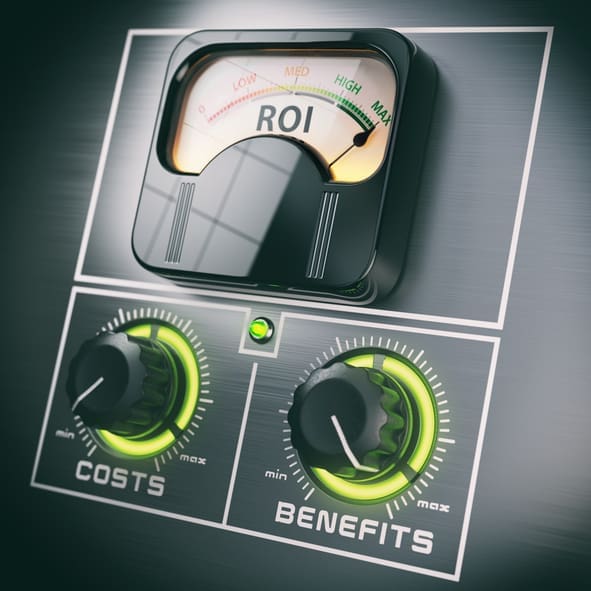How to Measure Marketing ROI
A Guide to Understanding and Measuring How the Marketing Efforts for Your Small Business Are Performing
According to NerdWallet, 47% of small business owners run their own marketing efforts. That can be a lot of pressure on top of the regular challenges of owning and operating your own venture, and there can be the temptation to either do the bare minimum because that’s all you have time for OR throw everything and the kitchen sink into the mix and just hope some of it pays off.
In reality, the best use of your time and your money is to focus on ROI and KPIs – i.e, return on investment and key performance indicators.
ROI and KPIs: What They Are
Pretty straightforwardly, return on investment is a calculation of how much you’ve lost or earned by dividing the net return on the investment by the cost of the investment. Key performance indicators tend to vary from business to business and are particular indicators of how your marketing campaign is doing when it comes to achieving your overall goals.
Both of these can be extremely useful when it comes to assessing whether your efforts are paying off in the right ways.
ROI and Types of Marketing KPIs
Let’s talk ROI first because this is likely the first checkpoint when you’re looking at your marketing campaign. Say you’ve been running paid ads, sending out marketing emails, and paying for local TV spots. You may have a case where one of these, like the TV spots, converts one out of five consumers, while the paid ads and emails average more like one out of ten. But the TV spots are expensive, and the cost of placing them isn’t made up by the business they bring in. The paid ads and emails might not convert at the same percentage, but they’re netting you better financial results because they’re less expensive.
Judging on ROI might mean cutting an element of your marketing campaign because it’s just not worth the money you’re putting into it.
The flipside of that are the key performance indicators. While ROI is a result, KPIs are something you decide on at the beginning of the marketing process to help you whittle down where you want to put your efforts.

Some types of marketing KPIs are:
- Email marketing engagement – Email campaigns can be extremely effective, as long as you’re paying attention to the metrics they’re giving you. Monitoring open rates, click-thru rates, download rates (if offering white papers, resources, etc.), and unsubscribe rates can be vital for knowing how your strategies are working.
- Website traffic rates – Are you getting more unique visitors to your site? Is overall traffic increasing? Are they sticking around or bouncing quickly? Which pages seem to keep people’s attention and which seem to drive them away?
- Conversion rates – What percentage of the people you connect with become customers? You can look at this over a large scale – i.e., how is overall web traffic converting – or drill down to individual landing pages, emails, ads, to see which ones are delivering.
- SEO performance – The higher you rank on a search page, the more likely you’ll be discovered by potential customers. But it’s more complex than just throwing your name and services out there. These days, you need to look at longtail keywords and phrases that hone in on your ideal customer and make it more possible for your business to land near the top.
- Social media engagement – More likes, more shares, more followers, more comments. All of these metrics can demonstrate improving engagement on your social media content and platforms.
- Cost per lead and lead quality – Especially in terms of things like paid search and targeted ads, cost per lead and lead quality become extremely important. If each lead is costing you more than it’s worth or the quality of the leads is poor, that tells you there might be a better avenue to spend your money.
- Brand awareness – It’s hard to expand your business if people aren’t aware of your business. This might tie in with social media engagement, but could also include things like customer reviews and recommendations, organic searches for your brand, etc.
- Customer acquisition and retention – How much marketing money goes in to acquiring a single customer (also known as, Cost Per Acquisition or CPA)? Relatedly, how well are you retaining customers and nurturing long-term relationships?
How to Decide Which Marketing Efforts to Focus On
It’s kind of a cascade effect. Before you can figure out your marketing KPIs, you need to figure out your concrete goals for your business. It doesn’t have to be a long-term plan. It can just be your goals for the next few months. Once you settle on those, you need to decide how you’re going to measure those goals. Which indicators will best be able to tell you how you’re doing. That’s how you can narrow down what kinds of KPIs you should prioritize.
Once you know your KPIs, you can structure your marketing efforts around that. For example, if social media engagement isn’t doing much to further your current goals, then there’s not much sense in putting time, money, and energy into social media content and ads. Don’t waste resources on a branch of marketing that get you where you want to be.
